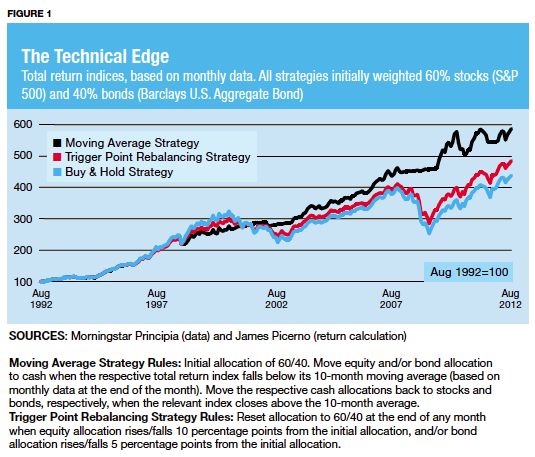Moving averages have captured the imagination (and
increasingly the managed money) of advisors these days, and it’s easy to see
why, at least through the lens of history. Consider a simple strategy benchmark
with an initial weighting of 60% stocks (represented by the S&P 500) and
40% bonds (by the Barclays Aggregate Bond index). Buying and holding this mix
earned you an annualized total return of 7.7% for the 20 years through August
2012 while it gave you an annualized volatility (standard deviation) of roughly
10.7. By contrast, your performance would have considerably improved with a
market-timing strategy that adjusted the same initially weighted allocation
using signals from a simple 10-month moving average (roughly the equivalent of
a 200-day average). You would have seen a return of 9.3% a year and volatility
of 7.9 (see Figure 1).

Here’s how the moving average strategy in Figure 1 works:
When the equity index falls under its 10-month moving average (based on monthly
data) at any month’s end, the entire stock allocation is moved to cash
(three-month T-bills). There it stays until the equity index closes above its
10-month average, at which point all the cash is shifted back to stocks. The
same rule applies to bonds. In short, the equity portion of the portfolio is
either in stocks or cash, and the remaining fixed-income allocation is either
in bonds or cash. The result is that this moving average strategy would have
sidestepped the worst of the corrections and crashes. If that sounds familiar,
it’s because similar results have been documented in numerous studies through
the years.
Figure 2 shows the differences in one-year returns for the
moving-average strategy minus the returns for the buy-and-hold strategy. The
dots above the zero mark indicate that the moving-average strategy outperformed
for the trailing-12-month period, and vice versa. For much of the past two
decades, annual returns between the two strategies shared relatively similar
results. But the differences widened dramatically around and during
recessions—overwhelmingly in favor of the moving-average strategy.

For this reason, finance professor Paskalis Glabadanidis
calls moving average-based strategies the equivalent of an “at-the-money put
option combined with a long position in the underlying risky asset” (a quote
from his working paper, Market Timing with Moving Averages.) In other words,
the main value of moving averages has kicked in when the market has trended
lower for an extended stretch—a bear market.
None of this should be surprising, says Adam Grimes, the
chief investment officer of Waverly Advisors and author of the recently
published book The Art and Science of Technical Analysis. “The major crashes
usually come well after warnings signalled by technical weakness.” The steep
sell-off in the stock market in late 2008 and early 2009, for example, started
about a year after equities set new highs. Soon after the peak, investors saw a
series of warnings in the moving-average signals.
That’s not unusual, notes Grimes. He adds, however, that there’s nothing
magical about 50- or 200-day moving averages—or any other rules for calculating
average prices. Moving averages, in all their variations, are simply tools that
quantify some of the “repeatable patterns that illustrate the psychology of the
markets.”
The main advantage of looking at prices through the prism of trailing averages
is that it takes a lot of the emotion out of analysing market trends, he
counsels. “You’d be much better off with this than making emotional decisions,”
Grimes says. Is it foolproof? No, of course not. “We don’t deal in
certainties—we deal in probabilities.”
Source:
(Re)Discovering Technical Analysis
















